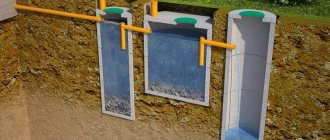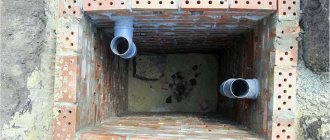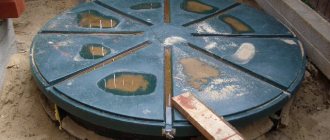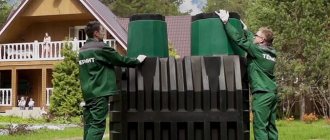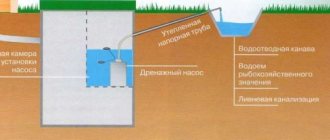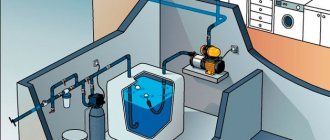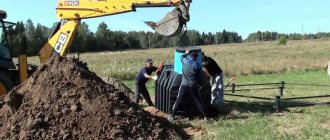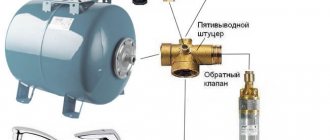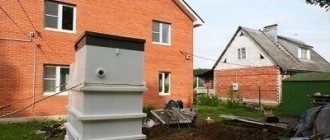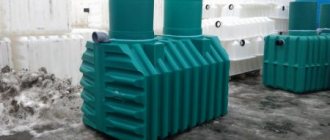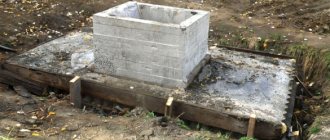The Termite septic tank is designed to solve one of the most important problems in landscaping a summer house or country house - installing a sewer system. A large selection of models that differ from each other in volume, productivity and degree of wastewater treatment allows you to select a unit of this brand for any area and number of consumers.
Termite is deservedly popular among the population of Russia and neighboring countries. Indeed, thanks to these structures, residents of areas remote from centralized sewerage systems can lead a completely comfortable lifestyle.
Description and principle of operation
The Termite septic tank is manufactured in the form of a cube or parallelepiped with one or two necks. The body of this VOC is sealed, solid cast and with stiffening ribs on all sides. It is made of polyethylene. Moreover, the manufacturer uses only primary raw materials; by definition, there is no recycled plastic at the plant.
Type of septic tank Termite for a summer residence
A typical Termite septic tank consists of three chambers inside:
- To receive wastewater, sediment heavy particles and release a fatty film on top of the water.
- For settling (final clarification).
- For the processing of organic matter by anaerobic bacteria.
Septic tank Termite in section
In some designs, the second compartment is combined with the first. They differ from the standard solution by having only one neck.
In the third (last) chamber of the septic tank there is a biofilter made of synthetic fabric and microorganisms on it, as well as another filter with pumice as a filler. Termit produces output water with a purification level of around 75–85%. Then it is sent to an infiltrator, which brings the purification percentage to 98, or to a sump for pumping out using sewage trucks.
Moreover, if the option with post-treatment by drainage is chosen, then the design of the house and the layout of the site should be immediately carried out taking into account the installation of this filter on a gravel bed. Then it will be difficult to find a place for it and a septic tank. The soil moisture near the infiltrator is always higher than at a distance from it. It’s definitely not worth using the same gas blocks or timber to build buildings next to it.
Manufacturing a septic tank at the factory
We weigh the pros and cons
Even before purchasing a treatment plant, it is worth getting acquainted with its advantages and assessing the existing disadvantages.
pros
Let's start by listing the advantages:
- the installation is autonomous, it works without power supply;
- the body is completely sealed, resistant to corrosion, and its thickened walls can easily cope with the load exerted by the soil;
- easy maintenance, the model is equipped with a filter that does not require replacement, it will be enough to wash it periodically;
- installation work is not difficult; immediately after installation is completed, you can begin using the sewerage system;
- a sufficiently high degree of purification allows you not to worry about the cleanliness of the environment;
- long service life, the structure can last more than 50 years;
- acceptable price.
Minuses
However, there are also disadvantages to using local treatment plants, in particular:
- the presence of an unpleasant odor is due to the occurrence of anaerobic processes of organic oxidation. During the activity of these bacteria, methane, hydrogen sulfide and other unpleasant-smelling gases are released, but this problem is present not only in this septic tank, but in any settling tanks;
- the product body has a rectangular shape and, according to user reviews, is often deformed at the corners;
- Periodically, sediment must be removed from the settling chamber using a sewer truck; this increases the cost of maintaining the sewerage system.
Modifications of the Termit septic tank
The model range of anaerobic septic tanks Termite is represented by two lines: “Profi” and “Transformer”. The first classic option is aimed at installation in summer cottages with seasonal residence, near bathhouses, cafes, etc. places. These stations have modifications in volume designed for 1–12 people, and are gravity-fed and energy-independent.
Based on performance and capacity, Termite Profi is divided into six modifications:
Model range of septic tanks Termit
- “1.2” for 1-2 people (400 l/day, 1200 l).
- “2.0” for 3-4 people, (800 l/day, 2000 l).
- “2.5” for 4-5 people, (1000 l/day, 2500 l).
- “3.0” for 5-6 people, (1200 l/day, 3000 l).
- “3.5” for 6-7 people, (1800 l/day, 3500 l).
- “5.5” up to 12 people, (2200 l/day, 5500 l).
Such a septic tank does not have any pumps. It doesn't need electricity to work. All flows inside and water discharge outside occur in gravity mode.
The Transformer septic tanks have two configurations: “S” and “PR”. The first is a compact autonomous sewer with one neck with a capacity of 500 to 1200 liters/day, designed for areas with low groundwater level. They, like the main model “Termite Profi”, are non-volatile.
The second are septic tanks for high groundwater, also designed for 500–1200 liters/day, but equipped with a drainage pump. Due to this, the forced release of treated waste is produced.
The Multplast assortment also includes “Termite” storage tanks, which are simply sealed containers for collecting sewage. Plus, there are autonomous “ERGOBOX” stations, which will be discussed in the next article. This is already an aerobic, energy-dependent septic tank with forced aeration inside.
Models of septic tanks Termit
| Septic tank | Human | LxWxH | Volume | Produces. | Price from* |
| Termite Pro 1.2 | 1-2 | 1340x1160x1565 mm | 1200 l | 400 l/day | 21500 rub. |
| Termite Pro 2.0 | 3-4 | 1595x1155x2005 mm | 2000 l | 800 l/day | 29900 rub. |
| Termite Pro 2.5 | 4-5 | 2000x1155x2005 mm | 2500 l | 1000 l/day | RUB 36,000 |
| Termite Pro 3.0 | 5-6 | 2300x1155x1905 mm | 3000 l | 1200 l/day | 43000 rub. |
| Termite Pro 3.5 | 6-7 | 2410x1190x2005 mm | 3500 l | 1800 l/day | 47900 rub. |
| Termite Pro 5.5 | 11-12 | 2220x1650x2395 mm | 5500 l | 2200 l/day | RUB 69,000 |
*Prices are indicative for 2021 excluding installation
Pros and cons of Termite septic tanks
The advantages of the Termite septic tank are as follows:
- A wide range allowing you to choose a model for any occasion;
- High level of purification (when using an infiltrator in the septic tank in question, it reaches 95–98%);
- Affordability in terms of the cost of the Termit VOC itself and its installation;
- Energy independence, which is very important for holiday villages remote from large cities;
- Full factory readiness of the septic tank for operation immediately after installation;
- Reliability, seamlessness and durability (up to 50 years) of the body.
Among the Termite septic tank models there are modifications both for normal conditions and for areas with high groundwater level. Plus, there is a solution for any number of people in the family. Moreover, if two dozen residents are planned to live in a house, then it is better to take a more productive autonomous station with aerobics.
The Termite septic tank has only two disadvantages:
- The need for additional treatment using an infiltrator or drainage well;
- It is mandatory to install a heavy “anchor” under the hull in case of high groundwater.
During installation, it is necessary to ensure that the Termite septic tank is filled evenly from the outside and filled with water. The stiffening ribs of the body may not withstand it if the chambers inside the VOC are empty. This is not cement-sand tiles or bricks, whose compressive strength is an order of magnitude higher. With strong external pressure, the polyethylene walls may well break through.
Video of how a Termite septic tank was crushed in the spring:
Features of operation
The maintenance procedure involves cleaning the receiving compartment from accumulated sediment. After 100% pumping of the device using a sewer truck, the device’s reservoir is filled with water. To ensure that such a need arises rarely, you need to:
- use anaerobic microorganisms;
- choose a cleaning mechanism of sufficient productivity;
- Stir the supergranules of the filter mechanism from time to time.
Timely special maintenance of the cleaning system will extend the service life of the device and reduce the need to turn to vacuum cleaners for help.
What is prohibited from being discharged into the cleaning system:
- building mixtures;
- paints and varnishes and household chemicals (paint, varnish, alcohol, solvent);
- petroleum products: gasoline, diesel fuel, antifreeze;
- large food waste: vegetables, fruits;
- medications;
- liquid that is drained after filtering the pool, since it contains an increased amount of reagents.
It is allowed to drain wastewater that comes from the kitchen (sink), bathroom (toilet), and bathroom (bathtub, washing machine) into the treatment station. If you follow these simple rules, the Termit septic tank will last even longer than the stated 50 years.
For more information on how to install a septic tank, see the following video.
Septic tank installation
The Termit septic tank is installed quickly and easily. The description of the rules for its installation is far from a step-by-step instruction for constructing a columnar foundation with your own hands or building a house in the country. With factory VOC everything is much simpler.
To install a Termit septic tank you need:
- Dig a pit in size so that the septic tank fits completely into it, and there is 20–25 cm of voids on each side between the walls of its body and the ground.
- Dig a trench from the sewer outlet from the house to the VOC and lay a pipe there with a slope of 2 degrees towards the septic structure.
- Make another trench with a pipe to drain water into the infiltrator.
- Inspect the septic tank body for damage; it must be sealed.
- Level the bottom of the pit and compact a 3–5 cm layer of sand there.
- Place the plastic structure inside the hole.
- Fill the sides of the septic tank with a sand-cement mixture in a ratio of 5:1, while simultaneously filling it gradually with water. The level of the latter in the chambers should exceed the level of backfill by 20–30 cm.
After this, all that remains is to insulate the Termite septic tank, if required, and finally fill it up. The infiltrator is made at a distance of 2–10 meters from the VOC. And remember, the latter must be set back from all buildings on the site and even beds by at least 5 meters. Otherwise, the humidity on the ground from it is such that even façade plaster for exterior use, which is highly moisture-resistant, will begin to slide off the walls of buildings nearby.
Watch a video about installing a Termite septic tank
Installation features for different soils
Installation of a Termit septic tank can be done in various ways, depending on the type of soil on the site:
Soil with normal water absorption
In this case, a system of drainage pipes is connected to the outlet of the Termit septic tank, through which water is absorbed into the soil. An irrigation dome can also be used. Its capacity depends on the performance of the septic tank.
Septic tank Termite with irrigation dome
Sandy soil
This soil absorbs moisture well, so any type of drainage is suitable. If the groundwater in the area is deep, more than 1.5 m, then a drainage well can be installed at the outlet of the purifier.
Septic tank Termite with drainage well
High groundwater level
If the groundwater level is high, an intermediate drainage well is used with the connection of a drainage pump and a check valve. Water from the well is pumped into an irrigation dome or onto the ground surface.
Constantly high groundwater levels
A drainage well is used, from which water is pumped into the irrigation dome. The dome is placed on the surface of the ground and additionally insulated with an earthen layer.
Installation of a septic tank with a high groundwater level
Clay soil
After the septic tank, a filtration field is constructed, consisting of several layers of crushed stone and sand. The water first passes through the filtration field and then enters the drainage well. From there it goes into the ground or is taken for household needs.
Reviews about the septic tank
Owners leave reviews for septic tanks under the Termit brand, both positive and negative. It will need to be cleaned of accumulated sludge every 2-3 years. If the groundwater is high, you will have to make an anchor for it, but this applies to almost all treatment facilities of this class. Among the shortcomings, owners who have been using Termit for several years note rather narrow necks. But this is more a matter of personal wishes.
Positive reviews
- I installed five Termite septic tanks this year. These septic tanks are analogous to Tank septic tanks. The thickness of the walls of the Termit (the manufacturer is not deceiving) is greater than that of the Tank; if the Tank 2 can be easily loaded into a car by two people, then the Termit 2F will have to be tinkered with. The stiffening ribs are also stronger than those of the Tank. Installation of Termite (taken from the technical data sheet) - the pit for installation must be 300 mm wider than the installation on each side, the container is installed on a layer of compacted sand cushion (100 mm). If the groundwater level is high, the container must be attached to a concrete slab. backfilling is carried out with a mixture of sand and cement; backfilling should be done in layers, with mandatory compaction. At the same time, fill the container with clean water so that the water level is approximately 200 mm above the backfill level. The upper surface of the septic tank is insulated (usually with polyethylene foam).
Installation must be done correctly. For example, in November last year, Tank dismantled two septic tanks due to improper installation; there were large pieces of clay in the sand-cement jacket, groundwater flowed through these inclusions, the septic tanks were compressed and they cracked. © Alexander F, forumhouse.ru
- The septic tank has been working wonderfully for six months now, nothing has been compressed, nothing has become clogged, and there is no smell. The bacteria were poured in once, but they haven’t been poured in again yet. We'll probably add it in the spring, otherwise during the winter all the bacteria there will fall asleep :) we don't regret the amount spent, because the quality is excellent! (While they were installing, through their own fault, they dropped the ladder onto the septic tank, everyone thought it would split, but no, he’s alive and well and nothing even happened to him!) In general, I recommend this product to everyone! Delivered within a week after ordering, excellent advice, reliable septic tank! © nolofinve, forumhouse.ru
- According to the strength of thermite. We had a hurricane here, fences and trees were knocked down, doghouses were scattered. Well, several inch boards 2-3 meters long flew into the end of my septic tank. Scores 3-4 millimeters deep appeared. But nothing broke through © VVSorokin, forumhouse.ru
- The first buyers who managed to purchase Termite in the first 6 months from the start of production had a positive experience and good impressions. © VodoUslugi, forumhouse.ru
Negative reviews
- Rectangle. Despite the stiffening ribs, it is subject to compression. It is advisable to sprinkle it with sand cement. And so is the septic tank and septic tank. © Vadim (spb), forumhouse.ru
- They arrived, it looks good, but the problem with the thickness of the walls is like a tank, somewhere thinner, somewhere thicker... and clearly less than stated

